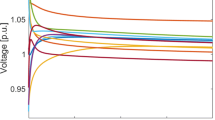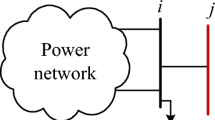Abstract
This paper presents a new nonlinear programming problem arising in the control of power systems, called optimal power flow with transient stability constraint and variable clearing time of faults and abbreviated as OTS-VT. The OTS-VT model is converted into a implicit generalized semi-infinite programming (GSIP) problem. According to the special box structure of the reformulated GSIP, a solution method based on bi-level optimization is proposed. The research in this paper has two contributions. Firstly, it generalizes the OTS study to general optimal power flow with transient stability problems. From the viewpoint of practical applications, the proposed research can improve the decision-making ability in power system operations. Secondly, the reformulation of OTS-VT also provides a new background and a type of GSIP in the research of mathematical problems. Numerical results for two chosen power systems show that the methodology presented in this paper is effective and promising.
Similar content being viewed by others
References
Chen L., Tada Y., Okamoto H., Tanabe R., Ono A.: Optimal operation solutions of power systems with transient stability constraints. IEEE Trans. Circuits Syst.-I Fundam. Theory Appl. 48, 327–339 (2001)
Clarke F.H.: Optimization and Nonsmooth Analysis. John Wiley, New York (1983)
Coleman T.F., Li Y.: An interior trust region approach for nonlinear minimization subject to bounds. SIAM J. Optim. 6, 418–445 (1996)
Drici Z., Lakshmikantham V., Walter W.: Convex dependence of solution of differential equations in a Banach space relative to initial time. Nonlinear Anal. 34, 629–635 (1998)
El-Hawary, M.E. (ed.): Optimal Power Flow: Solution Techniques, Requirement and Challenges. IEEE Tutorial Course, IEEE Service Center, Piscataway (1996)
Gan D., Thomas R.J, Zimmerman R.D: Stability constrained optimal power flow. IEEE Trans. Power Syst. 15, 535–540 (2000)
Gauvin J., Dubeau F.: Differential properties of the marginal function in mathematical programming. Math. Program. 19, 101–119 (1982)
Laufenberg M.J., Pai M.A.: A new approach to dynamic security assessment using trajectory sensitivities. IEEE Trans. Power Syst. 13, 953–958 (1998)
Li D., Qi L., Tam J., Wu S.Y.: A smoothing Newton method for semi-infinite programming. J. Glob. Optim. 30, 169–194 (2004)
Loxton R.C., Teo K.L., Rehbock V.: Computational method for a class of switched system optimal control problems. IEEE Trans. Autom. Control 54(10), 2455–2460 (2009)
Loxton R.C., Teo K.L., Rehbock V., Ling W.K.: Optimal switching instants for a switched-capacitor DC/DC power converter. Automatica 45, 973–980 (2009)
Mangasarian O.L., Fromovitz S.: The Fritz John necessary optimality conditions in the presence of equality and inequality constraints. J. Math. Anal. Appl. 17, 37–47 (1967)
Momoh J.A., Koessier R.J., Bond M.S., Stott B., Sun D., Papalexopoulos A., Ristanovie P.: Challenges to optimal power flow. IEEE Trans. Power Syst. 12(1), 444–447 (1997)
Ralph, D.: Nonlinear programming advances in mathematical programming with complementarity constraints, 2007, http://www.eng.cam.ac.uk/~dr241/Papers/
Stein O., Still G.: Solving semi-infinite optimization programs with interior point techniques. SIAM J. Control Optim. 24(3), 769–788 (2003)
Teo K.L, Goh G.J, Wong K.H.: A Unified Computational Approach to Optimal Control Problems, vol. 55, Pitman Monographs and Surveys in Pure and Applied Mathematics. Longman Scientific and Technical, England (1991)
Sumida Y., Iwamoto S.: Transient stability preventive control for stable operating condition with desired CCT. IEEE Trans. Power Syst. 17(4), 1154–1161 (2002)
Teo K.L, Jennings L.S., Rehbock V.: The control parameterization enhancing transform for constrained optimal control problems. J. Aust. Math. Soc. Ser. B 40, 314–335 (1999)
Tong X.J., Ling C., Qi L.: A semi-infinite programming algorithm for solving optimal power flow with transient stability constraints. J. Comput. Appl. Math. 217, 432–447 (2008)
Tong X.J., Wu F.F., Qi L.: On the convergence of decoupled optimal power flow method. Numer. Funct. Anal. Optim. 28(3–4), 1–19 (2007)
Tong X.J., Wu F.F., Zhang Y., Yan Z., Ni Y.: A semismooth Newton method for solving optimal power flow. J. Ind. Manage. Optim. 3(3), 553–567 (2007)
Tong X.J., Wu S.Y., Zhou R.: New approach for the nonlinear programming with transient stability constraints arising from power systems. Comput. Optim. Appl. 45(3), 495–520 (2010)
Xue A.C., Mei S.W., Ni Y.X., Wu F.F., Lu Q.: Critical clearing time estimation of power system based on quadratic approximation of stability region (in chinese). Autom. Electr. Power Syst. 29(19), 19–24 (2005)
Ye J.J., Wu S.Y.: First order optimality conditions for generalized semi-infinite programming problems. J. Optim. Theory Appl. 137, 419–434 (2008). doi:10.1007/s 10957-008-9352-Z
Yuan Y., Kubokawa J., Sasaki H.: A solution of optimal power flow with multicontingency transient stability constraints. IEEE Trans. Power Syst. 18(3), 1094–1102 (2003)
Author information
Authors and Affiliations
Corresponding author
Rights and permissions
About this article
Cite this article
Tong, X., Ling, C., Wu, SY. et al. Semi-infinite programming method for optimal power flow with transient stability and variable clearing time of faults. J Glob Optim 55, 813–830 (2013). https://doi.org/10.1007/s10898-011-9812-0
Received:
Accepted:
Published:
Issue Date:
DOI: https://doi.org/10.1007/s10898-011-9812-0




